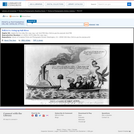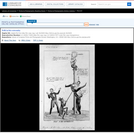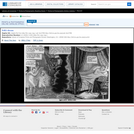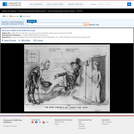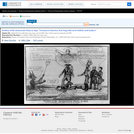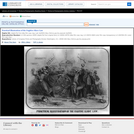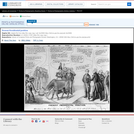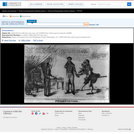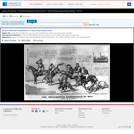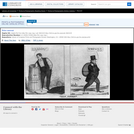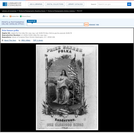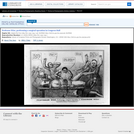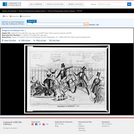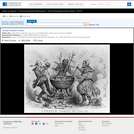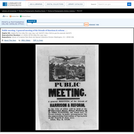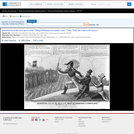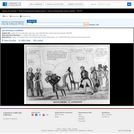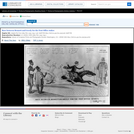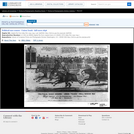
A figurative portrayal -- clearly sympathetic to the Whig party -- of the 1836 presidential election contest as a horse race between four candidates. The four are identified in the legend as (left to right): "Old Tippecanoe" (William Henry Harrison), "The Kinderhook Poney" (Martin Van Buren), "Black Dan of Massachusetts" (Daniel Webster), and "Tennessee White" (Tennessee senator Hugh Lawson White). The horses with the Whig candidates' heads are ridden by figures representing the various sectional interests of the country. Harrison is ridden by a frontiersman in buckskins, Webster by a Jack Downing/Uncle Sam figure symbolizing Yankee New England, and White by a jockey representing Southern agrarian interests. Van Buren, the Democratic candidate, is ridden by his advocate Andrew Jackson. A crowd cheers them on. The print probably appeared early in 1836 when Webster and White's respective hopes for the Whig nomination were still considered realistic. Moreover, the dialogue alludes to the Whig strategy pursued early in the campaign, of dividing the electorate regionally in order to attract the largest number of voters away from Van Buren. The horse in the lead is William Henry Harrison. His rider says: "Old Tip" has been in training but a short time, yet his wind and bottom are staunch as his backers are honest. I say "Old Hickory" that Kinderhook Nag of yours has been over trained!!! Jackson (whipping his horse and losing his hat): By the Eternal! I'll never back a Northern Horse again. They have neither wind nor bottom, and so cursed slippery withal that it's hard to keep your seat on them. The People too are all throwing their caps for "Old Tip" and "White Surrey," while this cursed "cold blooded" animal is disgracing his groom and training. I say Old Boy if you'll stop a minute I'll jump off & beat you myself. Southerner: The game is up! "Old Tip" is winning the prize notwithstanding the training of Old Hickory. I always told him when he was backing that "Cold blooded Kinderhooker;" he would find him wanting bottom in the hour of trial, & any thing but a race horse. Thank God he's beaten! so we may as well hold up." Jack Downing: " . . . I guess I'll jist tote along & kinder look out in case Old Tip he mout git a tumble. As for that tarnel "Kinderhooker," by ging he's used up & he wont only be distanced, but I kinder think he'll throw his rider into that 'are dirty pool near the Central Post!" Judging from similarities in theme, drawing style, and rendering of the figures (in particular the Westerner) to Edward Williams Clay's "Set-to Between the Champion Old Tip . . ." (no. 1836-12) attribution to Clay is reasonable.|Drawn by Edward Williams Clay?|Printed and published by H.R. Robinson, 48 & 52 Cortlandt St. New York.|Title appears as it is written on the item.|Weitenkampf, p. 45.|Forms part of: American cartoon print filing series (Library of Congress)|Published in: American political prints, 1766-1876 / Bernard F. Reilly. Boston : G.K. Hall, 1991, entry 1836-13.
- Subject:
- History
- U.S. History
- Material Type:
- Diagram/Illustration
- Primary Source
- Provider:
- Library of Congress
- Provider Set:
- Library of Congress - Cartoons 1766-1876
- Date Added:
- 06/08/2013
